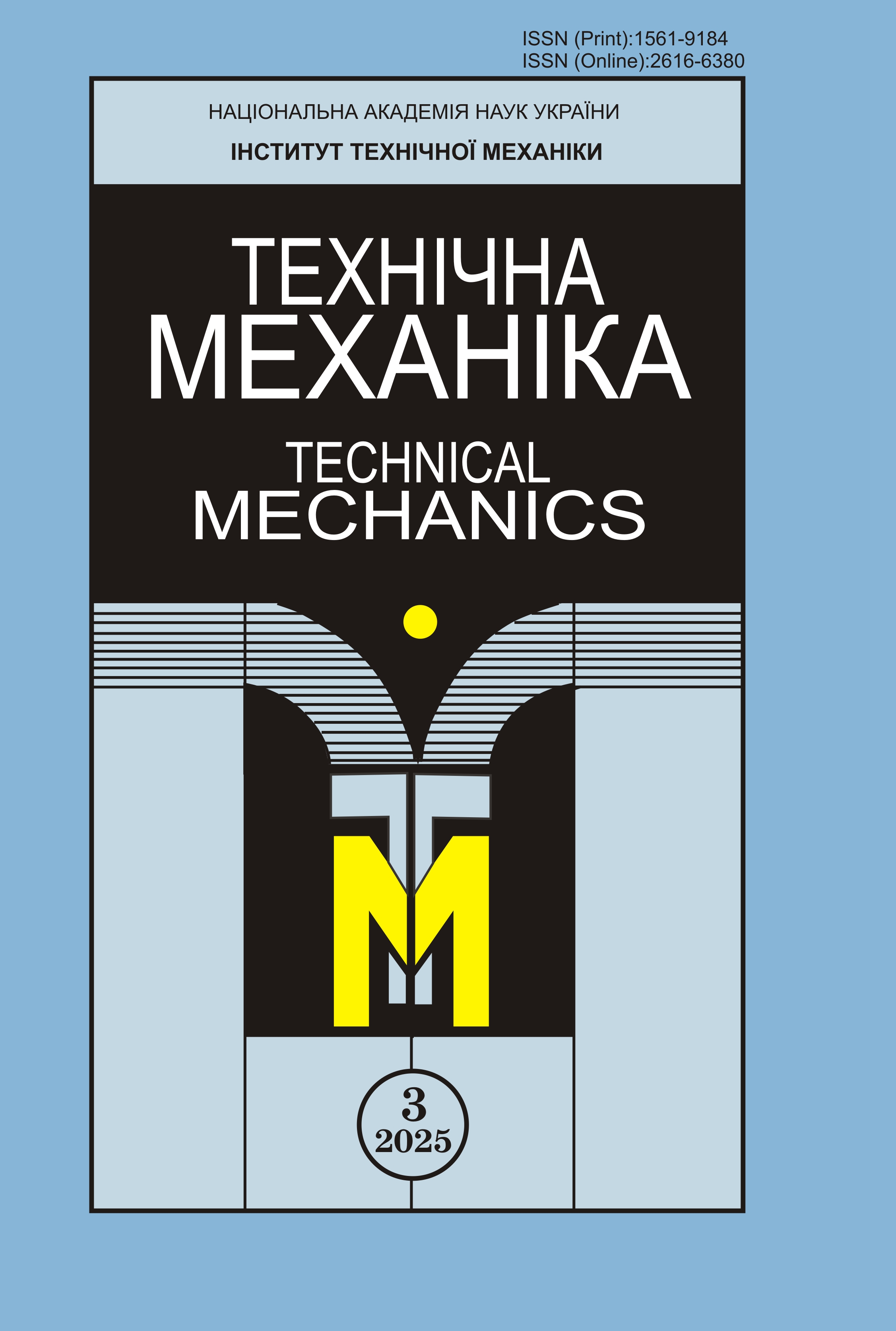ДВОКРИТЕРІАЛЬНА ОПТИМІЗАЦІЯ ПОСЛІДОВНИХ МАРШРУТІВ БАГАТОЦІЛЬОВИХ МІСІЙ НИЗЬКООРБІТАЛЬНОГО СЕРВІСНОГО ОБСЛУГОВУВАННЯ І ВИДАЛЕННЯ СМІТТЯ
Ключові слова:
багатокритеріальна оптимізація, генетичний алгоритм, орбітальна задача комівояжера, метод усереднення, мала тяга.Анотація
DOI: https://doi.org/10.15407/itm2025.03.087
З метою забезпечення стійкості космічної екосистеми розробляються нові типи місій, такі як місії орбітального сервісного обслуговування (ОСО) і активного видалення сміття (АВС). Використання ОСО і АВС на низьких навколоземних орбітах (ННО) має велику перспективу. Однак їх реалізація стикається з суттєвими проблемами. За останні десятиліття було запущено і експлуатувалося лише кілька успішних місій ОСО, тоді як місії АВС ще не були реалізовані на орбіті. В зв’язку з цим дослідження проблем, пов'язаних з обґрунтуванням і попереднім плануванням місій ОСО і АВС є важливими для покращення нашого розуміння цих операцій, а також для підвищення їх ефективності.. Здійснення ОСО і АВС тісно пов'язане з ефективністю виконання послідовності завдань орбітального маневрування в умовах обмеженості енергетичних можливостей сервісного космічного апарата (СКА). Величини показників ефективності для різних маршрутів ОСО і АВС можуть істотно відрізнятися. На теперішній час вже розроблено і продовжується розробка методів оптимізації маршрутів багатоцільових місій ОСО і АВС. Існуюча література переважно зосереджена на пошуку рішень, спрямованих на мінімізацію енергетичних витрат і скороченні загальної тривалості місій ОСО і АВС, оскільки саме ці фактори вважаються найбільш суттєвими при плануванні місій. Оптимізації маршрутів ОСО і АВС за критерієм безпеки перельотів, який суттєво впливає на вартість страхування місій, приділено суттєво менше уваги. Це обумовлює потребу в розробці оперативних методів багатокритеріальної оптимізації маршрутів ОСО і АВС з врахуванням критерію безпеки перельотів.
Метою роботи є розробка оперативного метода двокритеріальної оптимізації послідовних маршрутів багатоцільових місій ОСО і АВС, що виконуються СКА з рушійними установками малої постійної за модулем тяги. Задачу сформульовано у вигляді двокритеріальної орбітальної задачі комівояжера.
Методами розв’язку задачі є методи багатокритеріальної генетичної Парето оптимізації, усереднення диференціальних рівнянь і аналітичного моделювання міжорбітальних перельотів СКА. Використання генетичного алгоритму Парето оптимізації дозволило уникати локальних оптимальних розв’язків і обумовило прийняті обчислювальні витрати. Істотне зменшення обчислювальних витрат досягнуто також за рахунок використання аналітичного моделювання міжорбітальних перельотів СКА з рушійними установками малої постійної за модулем тяги. Новизна отриманих результатів полягає в розробці оперативного метода і двокритеріальної оптимізації послідовних маршрутів багатоцільових місій ОСО і АВС. Розроблений метод легко поширюється на збільшену кількість оціночних критеріїв. Результати роботи можуть бути використані при обґрунтуванні і попередньому плануванні місій ОСО і АВС на ННО.
ПОСИЛАННЯ
1. Ceif M. Multiple Space Debris Collecting Mission—Debris Selection and Trajectory Optimization. Journal of Optimization Theory and Applications. 2013. Vol. 156. №. 3. P. 761–796. https://doi.org/10.1007/s10957-012-0130-6
2. Murakami J., Hokamoto S. Approach for optimal multi-rendezvous trajectory design for active debris removal. 61st International Astronautical Congress IAC. 2010. P. 6013–6018.
3. Federici L., Zavoli A., Colasurdo, G., et al. Impulsive multi-rendezvous trajectory design an optimization, 8th European Conference for Aeronautics and Space Sciences (EUCASS). 2019. P. 1–4.
4. Jorgensen M. K., Sharf I. Optimal planning for a multiple space debris removal mission using high-accuracy low-thrust transfers. Acta Astronautica. 2020, Vol. 172. P. 56–69. https://doi.org/10.1016/j.actaastro.2020.03.031
5. Shen H.-X., Zhang T.-J., Casalino L., Pastrone D. Optimization of Active Debris Removal Missions with Multiple Targets. Journal of Spacecraft and Rockets. 2018. Vol. 55. №. 1. P. 181–189. https://doi.org/10.2514/1.A33883
6. Di Carlo M., Romero Martin J. M., Vasile M. Automatic trajectory planning for low-thrust active removal mission in low-earth orbit. Advances in Space Research. 2017. Vol. 59. №. 5. Р. 1234–1258. https://doi.org/10.1016/j.actaastro.2018.05.040
7. Yang J., Hu Y. H., Liu Y., Pan Q. A maximal-reward preliminary planning for multi-debris active removal mission in LEO with a greedy heuristic method. Acta Astronautica. 2018. Vol. 149. P. 123–142.
8. Barea A., Urrutxua H., Cadarso L. Large-scale object selection and trajectory planning for multi-target space debris removal missions. Acta Astronautica. 2020. Vol. 170. P. 289–301. https://doi.org/10.1016/j.actaastro.2020.01.032
9. Rossi A., Valsecchi G., Alessi E. The criticality of spacecraft index. Advances in Space Research. 2015. Vol. 56. №. 3. P. 449–60. https://doi.org/10.1016/j.asr.2015.02.027
10. Kechichian J. A. Reformulation of Edelbaum’s Low-Thrust Transfer Problem Using Optimal Control Theory. Journal of Guidance, Control, and Dynamics. 1997. Vol. 20. № 5. P. 988–994. https://doi.org/10.2514/2.4145
11. Zhang S., Han C., Sun X. New solution for rendezvous between geosynchronous satellites using low thrust. J. Guid. Contr. Dynam. 2018. Vol. 41. №3. P. 1397–1406. https://doi.org/10.2514/1.G003270
12. Han C., Zhang S., Wang X. On-orbit servicing of geosynchronous satellites based on low-thrust transfers considering perturbations. Acta Astronautica. 2019. № 159. P. 658–675. https://doi.org/10.1016/j.actaastro.2019.01.041
13. Гольдштейн Ю. М. Про вибір орбіти базування сервісного космічного апарата. Технічна механіка. 2020. № 3. С. 30–38. https://doi.org/10.15407/itm2020.03.030
14. Edelbaum T. N. Propulsion Requirements for Controllable Satellites. ARS Journal. 1961. Vol. 31. P. 1079–1089. https://doi.org/10.2514/8.5723
15. Корбут А. А., Финкелъшгпейн Ю. Ю. Дискретное программирование. Наука, 1969. 368с.
16. Popovici N. Pareto reducible multicriteria optimization problems. A Journal of Mathematical Programming and Operations Research. 2005. Vol. 54. Issue 3. P. 253–263. https://doi.org/10.1080/02331930500096213
17. Kim I. Y., de Weck O., L. Adaptive weighted-sum method for bi-objective optimization: Pareto front generation. Structural and multidisciplinary optimization. 2005. Vol. 29. P. 149–158. https://doi.org/10.1007/s00158-004-0465-1






